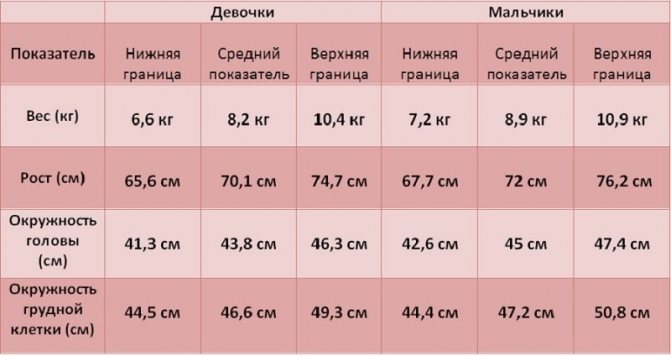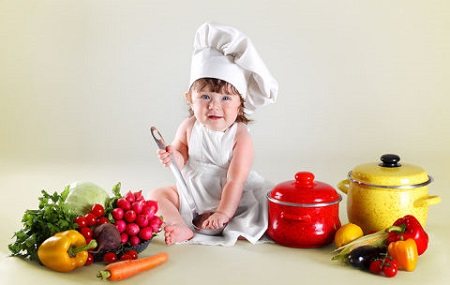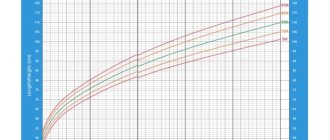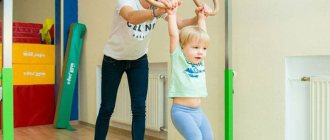Growth and development of a child at 9 months
In the ninth month of life, the baby gains 500 g of weight, the growth rate increases by 1.5 cm. Calculations of head and chest circumference become on average 0.5-1 cm larger.
Each child develops according to an individual schedule - both parents and pediatricians know this. But it is still necessary to focus on the average physical indicators of children of the same age, because this is how you can find out whether the baby has any errors in growth and what the pace of development of the child as a whole is.
The table below shows the main parameters of the physical development of 9-month-old children.
| Development parameters | Approximate normal values at 9 months | |
| girls | boys | |
| Height, cm | 68 – 73 | 70 – 76 |
| Weight, kg | 8,1 – 10,0 | 8,7 – 11,1 |
| Head circumference, cm | 45 | 46 |
| Chest circumference, cm | 44 | 45 |
Baby development at 9 months
As the child ages, his interest in everything around him begins to grow. He often crawls up to something, grabs onto objects, pulls them towards him, and tastes them. A nine-month-old baby becomes energetic and active, so special attention should be paid to him now. It is at this age that children often roll off sofas, fall out of strollers, and fall head first. Therefore, pediatricians recommend extreme caution when leaving the child alone in the room. It is better if he is in the playpen.
You should not give your child toys that he can bite or break off. Dolls and cars should be washed well. In addition, you need to select toys for your baby that can be held in your hands.
The child loves to watch his mother’s actions, evaluate the environment, and communicate. He has already learned to laugh loudly and prefers affectionate conversation. He knows how to play ok. Pronounces “mom”, “dad”. At the same time, he does not like loud sounds or situations in which he is deprived of mobility or forced to eat. The child shows his dissatisfaction with whims.
That's all the main points of a child's development at 9 months. We hope that our article was useful to you.
Basic skills: what a 9-month-old baby can do
A child in the ninth month of life stands confidently, leaning on the side of the crib, the wall or the hand of an adult.
If the baby feels sufficiently supported, he takes a few steps. The baby has not yet practiced walking independently and prefers to crawl to the desired location. By this age, a child masters the crawling skill with a bang - it can be difficult to keep up with a baby. Important! At 9 months, the period of attraction to objects at height begins, so parents should be especially vigilant and remove dangerous things that are slightly higher than the baby’s height.
So, what should a child at 9 months be able to do:
- Sit down independently from any position. A child can sit for 10-15 minutes without difficulty, while reaching for objects and pulling the desired toy towards him.
- The little fidget tries to climb onto low surfaces - sofas, chairs, armchairs, etc.
- Being near a support, he stands up independently and takes small steps. In baby walkers he squats, tries to jump, and moves tirelessly in them for up to 10 minutes.
- He actively uses the pinch grip in games. Tries to pick up small objects from the floor with two fingers.
- The child’s physical development also undergoes changes; the baby’s first milk teeth begin to appear (or continue to grow), sometimes several teeth erupt simultaneously.
- Speech is actively developing. The baby pronounces the cherished syllables “ma”, “pa”, “ba”. Gradually, the child’s speech includes new sounds and even short words (“on”, “where”, etc.).
- He holds objects in his hands tightly and confidently, but it is still difficult for a 9-month-old baby to unclench his fingers - he is fully aware of the entire “mechanism” of the process. Therefore, it can be extremely difficult to take away an object that he grabbed from a baby.
Developmental differences between boys and girls
Despite the fact that development in children of both sexes is almost identical, you can notice some features in the perception of the world, games, and behavior in girls and boys even at such an early age.
- Girls, regardless of temperament, show more interest in communication and emotions than boys. From infancy, the stronger sex is more interested in inanimate objects than people.
- Boys are often indifferent to sounds and voices than girls. That is why the vocabulary of women is replenished faster, which favors the early development of speech.
- Male children are better able to examine objects, play actively and develop spatial vision. Girls have more developed peripheral vision, and they will prefer attention and affection to toys.
Child at 9 months - weight and height
The increase in weight and height in babies during the ninth month varies from person to person. Some babies grow a little faster, others a little slower, but there's nothing wrong with that. On average, children gain 300 grams of weight and 1-2 centimeters of height. The circumference of the chest and head increases by 0.5-1 centimeter.
The height and weight of boys and girls at 9 months may differ. Boys are usually larger than girls, but this is not necessary.
Standards for height and weight of children WHO TABLES VIEW
Table of average weight and height indicators for boys and girls at 9 months

Neuropsychomotor development in the ninth month of life
The intellectual and motor development of a child at 9 months also gives parents many pleasant reasons to be proud of their baby. What new things can be noticed during this period?
- The baby has already managed to remember his name, and if he hears it, he reacts to it with a smile, turns towards the adult, and shows interest.
- The baby is able to express his emotions more vividly - when he is having fun, he rejoices and laughs; when angry, he shows resentment and even anger.
- Constantly points with his finger at different objects: those that he would like to touch (ask him to get something), and those he would like to climb into (please lift him to a high shelf, cabinet).
- Masters simple “yes” and “no” gestures. Reacts to requests from adults - “go to mommy”, “pick up the ball”, etc.
- He makes attempts to help his mother get dressed - he stretches out his arms, tries to insert his legs into his trouser leg. Pulls off his headdress on his own.
- Plays “hide and seek” with an adult, and can understand by voice or steps where the hiding parent is.
| Speech | The baby practices every day pronouncing entire chains of syllables. Many of them resemble the familiar words “mother” and “woman”. The child strives to imitate an adult, repeating those syllables that have already appeared in his babble - “pa-pa-pa”, “ma-ma-ma”, etc. |
| Hearing | With the help of auditory memory, he remembers and fulfills requests and verbal “instructions” - “kiss daddy”, “show mommy your pen”, etc. Can perform dance movements to a sound melody. |
| Vision | Observes what is happening around, pays attention to facial expressions and gestures of adults. Reacts to a smile, understands when mom is angry. |
| Emotions | Reacts violently (happily) to the appearance of mother in the room. Communicates with adults using simple gestures, pointing with a pen to an item of interest or showing dissatisfaction (waves his head). |
| Motor skills | Actively crawls, alternately moving the right and left pairs of limbs. At the support, he tries to immediately take a vertical position, standing on his legs. Stands confidently along the support and moves around, holding on with one hand. The child tries to grab small objects in the game with two or three fingers. |
| A game | The baby enjoys playing with several toys (objects) at the same time. During the game, he taps one cube against another. Prefers toys with musical accompaniment. If an adult hides a thing, the child will try to find it. |
Skills and abilities of a child at 9 months (video):
Daily routine of a nine-month-old baby
- The average daily sleep requirement for nine-month-old babies is about 14 hours. The number of periods of daytime sleep should not be less than two, while daytime sleep (in general) is 4-4.5 hours, and night sleep accounts for 9-10 hours a day.
- Breastfed babies may also continue to wake up during the night and demand the breast. But this need in babies is not due to hunger, but to the need to be close to their mother.
- Often babies at this age have problems sleeping. The reason for this is overwork during the day, a failure in the established regime. Teach your child to get up and go to bed at the same time, and the baby will begin to sleep peacefully and gain strength at night.
A 9-month-old infant’s daily routine is not much different from the content of the regimen of the last month of life. Small changes can be observed in the table below, which presents a variant of the rational daily routine of a nine-month-old baby.
| Time (in hours) | Mode element |
| 7.00 | Waking up the child, hygiene procedures, gymnastics |
| 7.30 | Breakfast |
| 8.00 | Wakefulness, active games |
| 9.00 | Developmental activities, reading with mom, listening to music |
| 11.00 | Snack |
| 12.00 | Walk in the fresh air, first nap |
| 14.30 | Dinner |
| 15.00 | Wakefulness, games, educational activities, massage |
| 16.00 | Walk in the fresh air, second nap |
| 18.30 | Snack |
| 19.00 | Staying awake, reading with mom, quiet games |
| 20.00 | Dinner |
| 21.30 | Evening bathing, getting ready for bed |
| 22.00 | Snack, bedtime |
Baby at 9 months - nutrition and sleep
The baby's diet becomes more varied due to the introduction of new products into the children's menu. In addition to vegetables, cereals and fruits, by 9-10 months the child is introduced to low-fat varieties of meat, fish and fermented milk products.
The timing of administration and products must be discussed with the doctor and adjusted according to the baby’s well-being.
Read more about the first feeding
The number of meals at 9 months is usually 5 or 6. Breastfed babies have one more nightly feeding than formula-fed babies. This is due to the fact that formula saturates the baby longer than breast milk.
A 9-month-old child sleeps 14-15 hours a day. The baby sleeps about 10 hours at night, the rest of the time is divided into two daytime naps.
Most babies wake up for night feedings, and infants wake up more often than bottle-fed babies. The older the baby gets, the less time he takes during the day, and the night sleep becomes stronger.
Relationship with the potty

A child at 9 months is ready to get acquainted with the potty, provided that he sits confidently and can sit down independently. It is better to make the first attempts to put your baby on the potty immediately after waking up and after a walk. Since at this time the child most likely wants to go to the toilet.
Don’t get carried away; the time spent on the potty should not exceed two minutes. Before one year of age, it is precisely the introduction to the potty that occurs; you should not expect that your baby will immediately start going to the toilet as expected.
Caring for a 9 month old baby
Care for a nine-month-old baby is based on the same techniques that were carried out by adults in all previous months, starting from the moment of birth. These are the three main components:
- hygiene procedures (washing, rinsing, evening bathing);
- light gymnastics;
- massage.
On a note! All care procedures should, if possible, be carried out at the same hours - this is how the child can gradually be accustomed to the daily routine and his routine can be established.
Bathing a baby at 9 months
The procedure for taking a bath at this age is usually already established by parents, and the baby enjoys spending time in the water. If a child likes to swim, then you can let him “splash” for 20-30 minutes, getting the baby interested in water fun: soap bubbles, boats, balls, rubber animals with sprinklers and cups for pouring liquid.
Advice! Children, as a rule, are already sitting well by nine months, so you can purchase a special high chair or circle for the bath. Such objects will provide a stable position and prevent accidental falls.
Massage at 9 months
Strengthening muscles at this stage of development is simply necessary - thanks to massage procedures, the baby improves the skill of crawling and prepares to master walking. The mother can perform the massage herself. You just need to remember a few basic points and techniques:
- The first massage sessions last no more than 10 minutes. The child should be calm and in a good mood. To relax, you can turn on calm melodic music;
- You need to start the procedure with soft stroking with your palms of the baby’s body parts - arms, legs, back and tummy. Hands are massaged from palm to shoulder, legs also from foot to hips;
- The tummy is massaged clockwise with light movements. When massaging your back, it is worth remembering that the spine does not need to be affected by the massage. The baby's back is massaged up/down along it, as well as towards the sides;
- It is especially important to spend time on the baby’s palms and soles, massaging each finger separately, this promotes the development of fine motor skills;
- The massage ends with gentle, almost weightless pats.
Gymnastics at 9 months
Exercise for a nine-month-old baby is an integral part of morning routine. It is performed before breakfast, in the first 10 minutes after waking up and is of a general strengthening nature for the child’s health.
This is what a set of gymnastic exercises for “beginners” looks like:
- we warm up the muscles of the arms and forearms: the child lies on his back, the adult bends and straightens the baby’s arms at the elbow joints, alternates with crossing them, then makes circular movements;
- we warm up the leg muscles: an adult alternately bends the child’s legs at the knees, imitating riding a bicycle, then bends and straightens the legs at the same time;
- turns are performed in both directions from the back to the tummy and back;
- sitting down and lifting the child’s body by straightened arms;
- crawling after an object/toy;
- rocking movements on a fitball in different body positions - lying on your stomach and lying on your back.
What can a 9 month old baby do?
- A 9 month old child can sit. You can also sit down on your own with or without support. The baby can remain in a sitting position for up to 15 minutes, playing or learning a new subject.
- A nine-month-old child stands up with the help of a support. Some babies at this age can independently move along the sofa or bed, holding on to their edges. Others may practice their first attempts at walking without support.
- By nine months, almost all babies can crawl on all fours. The only exceptions are those babies who do not crawl at all. Instead of crawling on all fours, they choose alternative methods of moving on their butts, on a leg tucked under their butts, or on their knees.
- A 9-month-old child actively interacts with toys. Rolls, throws, disassembles, assembles and invests. Easily selects and rearranges toys. The game becomes more exciting and can last 10-15 minutes without the participation of adults.
- The baby can grasp even the smallest objects with two fingers. Therefore, parents should pay attention to the space where the baby plays. After all, everything that the baby picks up can easily end up in his mouth.
- The baby already knows or is learning to chew solid food. Provided that by 9 months the baby has 5-6 teeth. If the baby has 1-2 teeth or does not have them yet, this skill will be delayed a little.
Video about baby development at 9 months
Sample menu for a 9 month old baby
By nine months, the baby’s digestive system is already quite strong. The first feeding is over, the baby has grown to the point where it is time to appreciate the variety of new tastes and their combinations in food products. The volume and quantity of enzymes produced for breaking down food increase with each week of life, and along with them, the body's immune defense mechanisms work better.
This is what a sample menu looks like for a baby in the ninth month of life:
| Eating | What do we eat |
| Breakfast | 90 g porridge, 60 g chopped fruit, 100-120 ml breast milk/formula |
| Snack | 100-150 ml fruit juice, 50 g boiled vegetable puree or diced cheese |
| Dinner | 60-90 g of meat puree, or yogurt or low-fat cottage cheese, 100 g of vegetable puree, 100-150 ml of breast milk/formula |
| Snack | 100 g finely chopped fruit or baby yoghurt, 1 baby biscuit |
| Dinner | 60-70 g of boiled meat in puree, 60 g of vegetable puree or rice, half of chopped fruit, 100-150 ml of breast milk/formula |
| Snack (before bed) | 150-200 ml kefir or breast milk/formula |
Important! The number of “milk” feedings is gradually reduced. In the 9th month of life, breastfed children receive mother's milk 3-4 times a day, and bottle-fed babies need 2-3 servings of formula per day.
What are we eating?
The table lists the main products that make up a child’s diet at a given period of life.
| Product | Serving Size |
| Kefir, baby yogurt, milk (for cooking porridge) | 150-200 ml per day |
| Meat purees (beef, pork, turkey, rabbit) | up to 50 g per day |
| Fish (cod, hake, haddock, salmon, pollock, trout) | We start giving it with 1 tsp, and over 2-3 meals we bring it to a serving of 50 g/day. Up to a year, give fish no more than 1-2 times a week. |
| Vegetables (broccoli, cauliflower, zucchini, potatoes, carrots, beets, pumpkin) and cereals (rice, buckwheat, corn, wheat, barley) | up to 180 ml per day |
| Fruit juices and purees (apple, pear, peach, apricot, plum) | 80-90 ml per day |
| Low-fat cottage cheese (no more than 3%) | no more than 40 g per day |
| Yolk | 20-30 g per day |
| Children's cookies, crackers | 5 g |
Delicious and healthy recipes for your baby
The diet of a nine-month-old baby includes up to 5-6 feedings per day, including snacks. Try to diversify your child's daily menu. Remember that properly prepared complementary foods are a source of nutrients for young children. Don't know what to cook for a tiny gourmet? We offer you several recipes for a complete children's meal.
Potato and zucchini salad
Wash and peel 2 medium sized potatoes. Cut the vegetable into small cubes, place in a small saucepan and fill it with water to half the volume. Peel half the zucchini, cut into pieces and add to the potatoes. Place the pan over medium heat and bring to a boil. After 5-7 minutes of boiling, drain the water, mash the vegetables and cool to room temperature. Add 1 tsp. vegetable oil (preferably olive oil).
Cod fillet with rice
Boil 1 liter of water in a saucepan. Add 1.5 tbsp to boiling water. rice and a small part (no more than 4-5 cm) of a peeled leek. Cook over low heat. After 15 minutes, add 30 g of chilled cod fillet to the pan. Cook for another 7 minutes, then remove from heat and pour the broth into a separate container. Mix rice with leeks and cod, add 2-3 tbsp. broth and season the dish with a couple of drops of olive oil.
Oatmeal with milk and peach
Wash 1 ripe peach, peel and chop using a coarse grater. Boil 100 ml of milk (fat content no more than 2.5%). Pour 1 tbsp into the boiling milk in a thin stream. oatmeal intended for cooking. Add grated peach. Simmer over low heat for 3-5 minutes, then remove from heat and cool until comfortable (porridge should be served warm).
Height and weight of a child at 9 months, data from domestic pediatricians
| 9 months | Bottom line | Upper limit |
| Boys' weight, kg | 7,9 | 10,5 |
| Girls' weight, kg | 7,5 | 9,7 |
| Boys' height, cm | 68,2 | 75,1 |
| Girls' height, cm | 67,5 | 74,1 |
| Boys' head circumference, cm | 44,0 | 47,4 |
| Head circumference of girls, cm | 42,9 | 46,4 |
| Boys chest circumference, cm | 44,4 | 50,8 |
| Girls chest circumference, cm | 44,5 | 49,3 |
Helping a 9-month-old baby develop
Babies at nine months spend a lot of time in their mother's arms. It is not easy to carry a baby for many hours a day, but before walking, the child needs to be “tame” - oddly enough, this is one of the stages of proper mental development.
We suggest paying attention to several important tips that will help to comprehensively develop a nine-month-old baby in a playful way.
Develop your speech
In order for your baby to accumulate a passive vocabulary, you need to talk to him daily and a lot. Don't know what to talk about with your baby? You can start by commenting on what is happening. “Mashenka will now get dressed and go for a walk with her mother,” “today Mashenka will eat porridge,” etc. Read books with nursery rhymes, memorable fairy tales, and poems in which words are repeated to your child.
Teach your baby to crawl
There are babies who, for one reason or another, do not show the desire to crawl, although they are completely healthy. Parents should make every effort to teach their child to crawl, this is an important step towards the subsequent development of walking. When trying to crawl, provide alternate support for its legs - this way, with your help, the baby will learn the technique of “cross” crawling.
Stimulate fine motor skills
Do a warm-up for your fingers every day. Let your child crumple and tear the paper, show how to crumple it. Have a sensory box with pieces of objects of different textures and materials (as long as they are safe!). Let the baby get acquainted with new tactile sensations (a sponge is soft, a bottle cap is hard, etc.).
Encourage physical activity
Does your child like to crawl and explore everything around? Don't put him in the playpen for a long time. An excellent solution could be a folding house with a tunnel. The baby will be happy to crawl into the house through the tunnel and back. You can bring this kind of entertainment to life without spending extra money by making a little house out of cardboard boxes.
Developmental activities for a 9 month old baby:
Baby's nutrition at 9 months
The baby's menu becomes more varied. The baby is already trying to steal some food from the table. It is best for the whole family to follow a proper and healthy diet. It’s convenient for both the mother, who doesn’t have to spend a lot of time on cooking, and the baby, who will have fewer food restrictions. Let's try to figure out what a baby's diet should be like at 9 months.
Diet features
The baby's main diet is still breast or artificial milk. In order to find out how much a child should eat, you need to make the following calculation:
- Divide the baby's weight by eight - nine, and get the age-appropriate amount of food per day.
At this age, five meals are provided per day. Try to maintain an interval between them of about 4 - 5 hours. But if a mother breastfeeds her baby on demand, then the regimen may be slightly different and vary depending on the baby’s needs.
The diet also largely depends on how other children in the family and the parents themselves eat. If there are older children in the family, then the baby may become familiar with some dishes much earlier than planned. Don't be too afraid of this.
It is not for nothing that today there is a method of pedagogical complementary feeding. It means that the little one is slowly trying everything that is being eaten at the common table.
Gradually introduce your baby to solid foods. At night, babies may still wake up and ask for the breast. This is not because they are hungry. Children need their mother, and he sleeps more peacefully if he constantly feels his mother’s presence nearby, to which he is accustomed.
Depending on the type of primary feeding, the child’s diet can vary significantly.
Breast-feeding
The menu of a breastfed baby at 9 months can be very different, depending on the age at which you introduced complementary foods. If you started complementary feeding at six months, you will most likely need to continue introducing new foods at this age.
Introduction of new products
- Egg yolk. Introduced into the second feeding. Best combined with porridge.
- Cottage cheese and fermented milk products. Introduced into the fourth feeding, as an afternoon snack.
- Porridge made with cow's milk. Administer gradually, with caution.
Read more about complementary feeding Introducing new products into complementary feeding
Artificial feeding
The menu of a 9-month-old bottle-fed baby most likely already contains the products that we listed above. After all, such babies often begin to eat complementary foods earlier. If you have not entered them yet, do it according to the same scheme.
To determine how much formula your baby needs per meal at this age, divide the daily amount of food by the number of feedings.
Child's menu
If you have already introduced all the main products into your baby’s menu, then you already know what to feed your baby. Gradually introduce into your diet dishes prepared from a mixture of various vegetables, as well as porridges prepared from various grains.
Let's look at an approximate menu for a 9 month old baby.
- Vegetable purees (150 - 180 g);
- Fruit puree or fruit (50 - 80 g);
- Porridge (up to 180 g); Meat (up to 50 g);
- Yolk (up to 2 times a week);
- Cottage cheese, kefir (up to 40 g);
- Wheat bread (5 g);
- Oil (5 g);
- Juice (up to 80 g).
Always remember that it is you, as parents, who determine what your child can eat. You know your baby better than anyone else. If your baby has intolerance to certain foods, take this into account. If necessary, seek help from a competent specialist.












